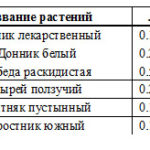Belozubova N.Yu., Zubkova V.M. BIOGEOCHEMICAL ACTIVITY OF PASTURE PLANT SPECIES IN THE LEAD, CADMIUM AND ARSENIC UPTAKE UNDER CONDITIONS OF THE VOLGOGRAD REGION // Arid ecosystems. 2021. V.27. № 3 (88). P. 81-88.
Production of livestock products in the suburban areas of urban agglomerations, including in the Sarpinskaya lowland steppes – a territory favorable for animal husbandry, is economically profitable due to the proximity to produce processing and consumers.
At the same time, such zones are subject to the airborne technogenic impact of urban industrial enterprises, which are sources of heavy metals and arsenic entering the ecosystems (Belozubova, 2011). In this regard, the study of the distribution of pollutant elements in agrocenoses adjacent to industrial centers is becoming increasingly important.
The biogeochemical activity of plants belonging to the legume family (Fabaceae) – plaster clover (Melilotus officinális (L.) Pall.) and arctic clover (Melilotus albus (Medik.) H. Ohashi & Y. Tateishi), the family of cereals (Poaceae) – couch-grass (Elytrígia répens (L.) Nevski), desert wheatgrass (Agropýron desertorum (Fisch.) Schultes) and common reed grass (Phrágmites communis Trin.), the goosefoot family (Chenopodiaceae) – common orach (Átriplex patula L.) was researched.
A high degree of arsenic accumulation by the roots of all studied plants, except plaster clover (Melilotus officinális (L.) Pall.); the highest biogeochemical activity in the uptake of Pb, Cd and As by the aerial part of the common orach (Átriplex patula L.) and the roots of the desert wheatgrass (Agropýron desertorum (Fisch.) Schultes) were found.
Keywords: Volgograd Region, Sarpinskaya lowland, light-chestnut soils, pasture plants, pollution, heavy metals, arsenic.
DOI: 10.24411/1993-3916-2021-10167


